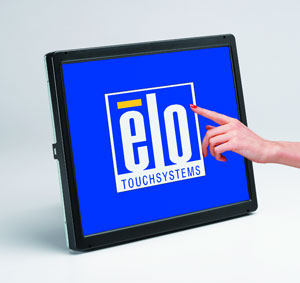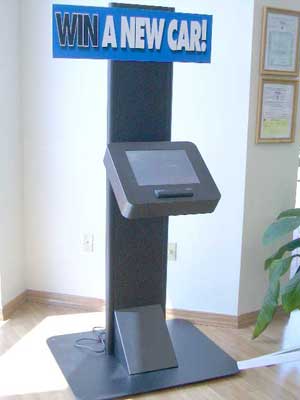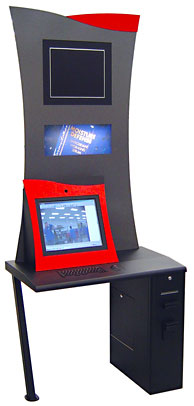The incredible shrinking kiosk
Will Rogers famously urged people to buy land, because "they ain't making it anymore." The same can be said of retail floor space - and with every square inch in high demand, pressure is on the kiosk to get smaller and more efficient.
March 29, 2005 by James Bickers — Editor, Networld Alliance
Will Rogers famously urged people to buy land, because "they ain't making it anymore." The same can be said of retail floor space - and with every square inch in high demand, pressure is on the kiosk to get smaller and more efficient. Finding space for a kiosk deployment can be tough - retailers know how valuable their space is, and they know that whatever they put there had better perform. So two strategies begin to converge for the kiosk: get better at what you do while simultaneously getting smaller. "Yes, kiosks are getting smaller, and there are several reasons for that," said Mike Sigona, marketing manager for Elo TouchSystems. "Larger retailers measure revenue per square foot of floor space. That conflicts with placing a large kiosk at the point-of-purchase where it would be most effective."
 This story and all the great free content on Kiosk Marketplace is supported by: This story and all the great free content on Kiosk Marketplace is supported by:
Swecoin US  Best of breed thermal kiosk printers Best of breed thermal kiosk printers
|
Sigona said that this conflict resulted in the past in kiosks being shoved out of the way, in more remote parts of a store. But thanks to the dawn of LCDs, and an overall trend toward smaller kiosks in general, that is changing. "Kiosks are now being designed significantly smaller, and can be placed much nearer the products they are promoting," he said." "On the whole, cost is the most prominent target for reduction, but it is followed very closely by space," said Kevin Kent, director of business development for
Swecoin U.S., Inc., a Rhode Island-based company that specializes in the design and implementation of thermal printers. "In fact, you can be involved in the early stages of a retail deployment and the space requirements will be a larger concern than price and may ultimately determine whether the project endures."
Downsizing the footprint Kent said that Swecoin has been acutely aware of the importance of maximizing space efficiency in its designs, and increasingly so in recent years. "In the last couple of years, we pushed ourselves to reduce our size by 50 percent," he said. "The technology is catching up with the ability to downsize the kiosk," said Ben Wheeler, sales manager for Waukesha, Wis.-based APW. "All-in-one panel PCs are not as far behind standard PC technology as embedded technology used to be. All of these things come to the cost line." There is another disparity in play that is affecting all of this: flat-panel LCDs are getting cheaper, tempting kiosk manufacturers to keep increasing the size of their displays. This necessarily has an impact on enclosure size. "The fact that 17-inch LCD monitors are becoming as cheap as 15-inch LCDs definitely draws the kiosk provider toward a bigger monitor, which offsets some of the trending toward smaller kiosk enclosures," said Wheeler. "That 17-inch monitor is advertising space that can be sold or used to attract users, so that will continue to fly in the face of this trend." Elo's Sigona disagrees with the cliché that "displays are growing, everything else is shrinking." He says that LCD-based kiosks are just beginning to approach the optimum dimensions that were common for CRT-based machines.
 |
Elo's 1749L 17-inch LCD touchmonitor |
"The ideal size has always been around 17 inches, based on human factors," he said. "It's large enough to attract customers from a distance, but also gives a feeling of privacy while being used." So while 40-inch plasma displays will have their uses, privacy and security dictate a breaking point when it comes to the maximum size of a display on a kiosk that deals with sensitive or personal information; nobody will want to fill out a job application, or punch in a credit card number to make a purchase, on a screen that can be seen across the room. Even if 17 inches is a "magic size," Sigona said there is much that can be done to shrink both display and kiosk. "Many kiosk designers, especially in Europe where retail space is very expensive, compete on every centimeter they can eliminate in their overall footprint, as much as they do on style and technical features," he said. He added that Elo's new 1749L touchmonitor is an example of how technology is enabling LCD displays to get thinner and narrower: the unit is about 10 percent smaller in height and width, and 13 percent thinner, while still boasting a 17-inch display. "This allows kiosk designers to build kiosks not much wider than the LCD panel itself," he said.
The importance of modularity As the overall size of a kiosk shrinks, the importance of smart design on the inside rises proportionally: a huge, roomy box has the luxury of spaghetti wiring and haphazard component placement, but when space is at a premium, layout and planning become crucial.
 |
Wirespring's modular design allows the same head unit to be used either free-standing or wall-mounted; static signage at the top can be replaced with an LCD or plasma display. |
"Modularity is a must," Wheeler said. "The issue is that you get this miniature PC, but you still have to accommodate for that RJ45 jack and all the cables, and now they are in a much more confined space to get connected." Bill Gerba, chief executive officer of Fort Lauderdale, Fla.-based WireSpring Technologies, also sees modularity on the rise. "Yes, we're seeing more movement toward modular, standard parts," he said," especially those that used to be limited only to higher-end rack servers. These have come down in price to where they now make sense for kiosk and digital signage systems." Given the fixed size of the display, kiosk designers can begin with that width and begin working backwards. For most popular kiosk uses, two particular components present a challenge when it comes to downsizing: the motherboard and the printer. "In reality, the motherboard is the hardest piece to shrink down," Gerba said. "Our preference is to use standard, widely available Micro-ATX motherboards in kiosk systems, so that you're not dependent on any specific component vendor for a more exotic form factor."
The joy of printers When asked which component gives him the biggest challenge in terms of space efficiency, Wheeler doesn't hesitate. "Printers," he said. "Dang paper rolls! And they want to have a space for an extra roll to boot!" The printer does indeed provide one of the enduring challenges when it comes to making kiosks smaller. Customers don't care how big a processor chip is, so long as it does what they want it to. They don't care how elegant the internal wiring of a kiosk is. But printers produce something that the customer holds in their hand, and minimum sizes are not to be tinkered with lightly.
 |
A reduced form-factor design by APW |
There is also the storage issue, which Wheeler alluded to: What to do with all that blank paper? "There are some limits, and one of them is directly related to printing: storing large amounts of paper," said Swecoin's Kent. "The beauty of a self-service application is that it can run for long periods of time without intervention. Whereas in the past, placing a 10-inch roll of paper inside an average kiosk was fairly easy, now the real estate inside is extremely limited." This is one area where tech advances do not hold as much promise; digital innovation can make electronic components smaller and smaller, but paper is a tangible thing, and shrinking it is not an option. One less-than-ideal solution is storing less paper in the kiosk, but that simply results in increased costs in the form of maintenance and refilling. So companies like Swecoin continue to find smarter ways to work around the problem. "We have had customers design a separate housing altogether for the printer and paper," Kent added. "In that way, the definition of a kiosk might be altered."
Cutting size, not corners In the race to make kiosks smaller, it is important to remember that some things simply cannot change. "Components can be modular," Wheeler said, "but how much smaller can a bill validator be when a bill is a certain size? How much smaller can an 8.5-inch by 11-inch document printer be when it has to be that size?" So there will be a definite temptation to cut corners in order to meet the demand for smaller kiosks: reducing the amount of paper stored for the printer, or using cheaper components to offset other expenses. But these savings are always temporary, and smart designers know that long-term quality always trumps short-term gain. "Printer manufacturers, like kiosk designers, will thrive or die away over the coming years on the strength of their design teams," Kent said. "Quality is no longer hyperbole - it is evident from the first prototype. Components cannot be crammed in a small kiosk, they must be carefully architected in. "Kiosk printer design operates the same way - you need to utilize every ounce of knowledge and creativity to architect expanded functionality into half the space."
About James Bickers



 This story and all the great free content on Kiosk Marketplace is supported by:
This story and all the great free content on Kiosk Marketplace is supported by:











